When Mother Nature came up with wood it gave it magical properties that try as we might we mere humans find it difficult to improve upon or to transfer to other materials we come up with.1 One of these magical properties of wood is its ability to regain it original dimensions after being repeatedly wetted and dried. Wood gets wet and it expands. It dries and it shrinks. No magic or mystery there. The magic is that no matter how many times wood gets wet and expands it always comes back to its original dimension when it dries. Always. Think about how remarkable that is?
Think of wood as a material that is made up of a combination of coil springs that are compressed by rubber bands. When wood picks up water it expands—the coil springs exert an outward force and expand in length but are restrained as to how far they expand by the rubber bands. They can never expand beyond the limit established by the fiber saturation point—the elastic limit set by the rubber bands. Wood can store water in its pore structure beyond the fiber saturation point but it does not get any bigger. With the dominant species of wood used in North American construction—spruce/pine/fir (SPF)—fiber saturation is around 28 percent moisture content by weight.
Now get this, with wood, the rubber bands never break.2 The rubber bands never get over stretched—no “plastic deformation” in the “classic” sense. And the springs never wear out—no “fatigue” in the “classic” sense. No matter how many expansion and contraction cycles. Wood is a perfect harmony of coil springs and rubber bands.
Some woods expand and contract more than other woods. As the density of wood increases dimensional change increases. A good number to remember for the density of wood we use to build with (SPF) is approximately 25 lbs/ft3. Not all woods are the same. Oak is close to 50 lbs/ft3. Hardwoods have higher densities than softwoods. That is why they don’t hold paint as well. The lower the density of wood, the better it holds paint. Balsa wood is great at holding paint because of its low density—less than 10 lbs/ft3. Because it does not expand and contract very much the paint film on it does not stretch and shrink as much. But balsa is a terrible construction material except for building model airplanes.
Paint films and coatings in general, like dimensionally stable substrates. The more the substrate moves, the more likely the paint will debond. One of the magic characteristics that make for a good paint is elasticity. The more elastic it is the more likely it will be able to stick to something that likes to move a lot—like wood. Paint used to coat wood also needs another real important characteristic—it needs to be vapor permeable so that the wood is able to dry. The easier and faster wood dries the less likely it will get real wet and get as big as it can get. Because once it gets real wet it will also eventually get real dry and the difference between real wet and real dry is a big change in dimension. The trick is how to make the paint both elastic and vapor permeable. Not an easy thing to do because the things that you do to paint films to make them elastic also tend to make them less permeable. And even more difficult is if you get a paint film to be elastic and vapor permeable how to get it to stay that way when you put it outside and expose it to the sun and other nasty things like oxygen.
We actually have paint coatings that now do both of these things extremely well. They are called latex paints or acrylic latex paints - paints that are both elastic and breathe. The trouble with them is that the do not always age very well. Think of a latex paint film as a bunch of long chain polymers that resemble spaghetti that are very slippery when first applied. The spaghetti sauce—Mama’s secret recipe that contains ammonia and detergents and other stuff whose proportions are guarded more closely than NSA’s surveillance plans—coats these spaghetti strands making them slide by each other with great ease. Fresh spaghetti and fresh sauce make for a very elastic film.
It gets worse with paint films on the south and west side of buildings. Wood claddings move more on the south and west side because they go through greater temperature differences which lead to greater relative humidity differences which lead to greater moisture content differences. The biggest stresses on the paint films also happen on the orientations where they get the most brittle. Paint tends to fail on south and west orientations more because of greater solar exposure and greater substrate movement (Photograph 1).
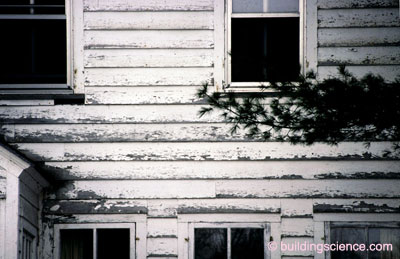
Photograph 1: Painted Wood Siding—Wood claddings move more on the south and west side because they go through greater temperature differences which lead to greater relative humidity differences which lead to greater moisture content differences. The biggest stresses on the paint films also happen on the orientations where they get the most brittle. Paint tends to fail on south and west orientations more because of greater solar exposure and greater substrate movement. Notice that the bottom edges loose the paint first. Old guys noticed this as well hence the practice of back priming at the overlaps. This is old siding with old paint – the non elastic non vapor permeable stuff – alkyd paint. Modern paints don’t do this. Having said that, it is still a good idea to back prime wood siding and back ventilate it by installing it over furring even when using the new stuff.
Nothing new here so far. Old timers learned to put wood siding on furring to back ventilate the wood so the wood would stay drier and not move as much so the paint would stay on the siding longer. Old timers also learned to “back prime” the siding so they would not get wet at the overlaps due to capillarity so they would not move as much so the paint would stay on them longer.
We have been trying to improve wood for over 5,000 years. Folks started gluing thin strips of wood together to improve its properties in Ancient Mesopotamia. Plywood goes back that far. Modern plywood was invented by Immanuel Nobel, the father of Alfred Nobel, in the 1800’s. Neat connection, eh? The apple doesn’t fall far from the tree. Plywood really got rolling during the Second World War and we have talked about this before (see “BSI-038: Mind the Gap, Eh?”). The thing about plywood is that its density is close to that of real wood. For reasons the will become evident real soon, this is a good thing. Plywood has a very good balance between its coil springs and rubber bands. Not as good as real wood, but pretty darn close.
About a century ago we tried to “improve” wood by flaking it and then putting the flakes into a pressure cooker and pressurizing them and then releasing the lid so that the wood flakes would explosively decompress. The residuals were then washed out leaving only fibers. These fibers were then “smooshed” together under heat and pressure so that the fibers would stick to each other creating a material with uniform predictable properties—unlike that pesky stuff Mother Nature invented. It was much denser than regular wood—twice as dense in fact. It was also much harder than regular wood—so much so that it was called “hardboard”. We used this “hardboard” for all kinds of stuff including siding and roofing.
Problem was that the perfect harmony of coil springs and rubber bands real wood has was not transferred to the hardboard. When the hardboard got wet and expanded and then subsequently dried it did not always quite get back to its original dimension. Sometimes the elastic bands would be stretched too far and they would “plastically” deform or even break. The repeated wetting and drying would lead to irreversible thickness swelling. There appeared to be a “critical degree of saturation” at which the process would initiate.3 Moisture content cycling below this level would have no effect, but above this the product would get thicker and thicker with repeated wetting and drying cycles. The thickening would happen first at the bottom edges of the boards at the overlap. It was often called “brooming” after—yup here it comes—a broom. The bristles of a broom flair out at the bottom just like the siding laps. It was as if the wood was trying to get back to its original density. The hardboard would start out at 50 lbs/ft3 and would end up at around 25 lbs/ft3 when the process was done. Mother Nature apparently has a sense of humor. You start out with 1-inch of wood and you compress it to ½-inch doubling its density. Over time the wood ends up back at 1-inch. The 1980’s were not a good decade for the hardboard industry (Photograph 2, Photograph 3 and Photograph 4).
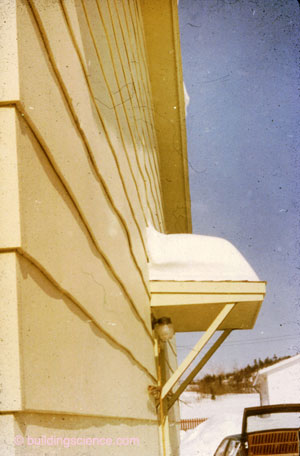
Photograph 2: Hardboard Siding Growing in Length—It buckles when it grows in length. We looked at this before (“BSI-023: Wood is Good….But Strange”).
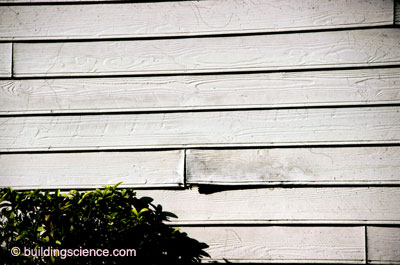
Photograph 3: Hardboard Siding Getting Thicker—The thickening happens first at the bottom edges of the boards at the overlap. It was often called “brooming” after the bristles of a broom that flair out at the bottom. It was as if the wood was trying to get back to its original density.
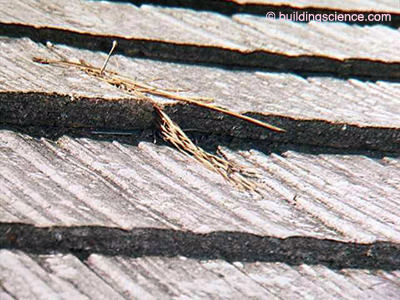
Photograph 4: Hardboard Shingles —Yes, folks tried to make shingles out of hardboard.
The wood industry eventually solved this problem by adding more rubber bands and messing with the springs4 but not before many of the manufacturers got out of the business due to our friends in the Plaintiffs Bar. Most hardboard today is found indoors as interior trim and interior doors. Not too many folks appear to be ready to go back and use hardboard on the exterior buildings at this point in time. Still too many bad memories.
After plywood and hardboard we got oriented stand board (OSB). OSB is pretty neat stuff when done right. You flake the wood and stick the flakes together with resin under heat and pressure. OSB that we typically see in construction has a density of around 40 lbs/ft3. Rubber bands and coil springs again. A lot of builders did not like OSB at first. And for good reason. It took the industry a while to figure out how to make good stuff. The good stuff has a lot more rubber bands than the bad stuff. With sheet OSB it became pretty clear that edges were where the action was (Photograph 5). A lot of design and trial and error went into the design of OSB edges to protect them from edge swell. I don’t know of a builder that hasn’t experienced this. The good news is that it does not have to happen. You can get OSB that does not do this. Of course you get what you pay for.
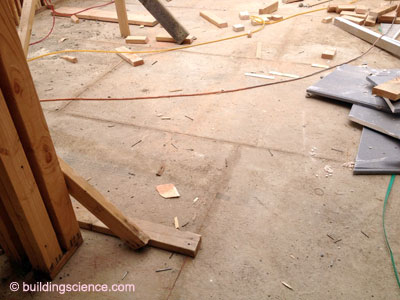
Photograph 5: OSB Edge Swell —Notice the swelling at the edges of the OSB sheet subflooring. The good stuff has a lot more rubber bands than the bad stuff. This is not good stuff. With sheet OSB it became pretty clear that edges were where the action was. A lot of design and trial and error went into the design of OSB edges to protect them from edge swell. I don’t know of a builder that hasn’t experienced this. The good news is that it does not have to happen. You can get OSB that does not do this. Of course you get what you pay for.
It got real exciting for a decade when some folks thought they could make siding out of OSB. The 1990’s were a mess. The OSB siding made during this time period was so bad it made folks forget about the hardboard siding problems in the 1980’s (Photograph 6). The OSB siding problems were the same as hardboard problems, only worse. Did this get eventually get fixed? The Jury is still out. Pun intended.
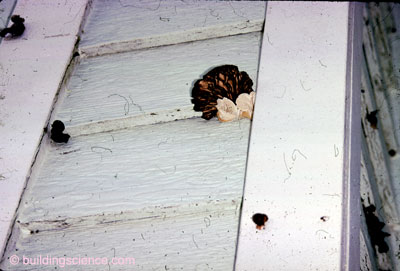
Photograph 6: The “Wolfgang Puck” Effect—Yes, those are mushrooms growing out of OSB siding made in the 1990’s – they might even be edible. Notice the thickening at the bottom edges of the boards at the overlap causing the paint film to fracture allowing even more water uptake via capillarity at the bottom edges.
Can OSB siding work? Yes, but be careful. The wood industry finally figured out how to make hardboard siding work, unfortunately too late for most of the industry, and is figuring out how to make OSB siding work. OSB siding requires lots of rubber bands and magic. And back ventilation and drainage and luck.
While all the excitement was happening with hardboard and OSB even weirder stuff was being developed. A Czech guy5 came up with fiber cement using cement and asbestos fibers at the turn of the last century. We all know how the asbestos thing worked out. Ouch. The good news was that the asbestos fibers were replaced with wood fibers. Then a whole bunch of materials science magic was added during the last couple of decades and fiber cement siding is now a pretty common cladding. Folks like it because it does not burn and it does not rot. But it can split and crack if it is not engineered correctly.
To understand fiber cement we need to understand reinforced concrete and Tinkertoys.6 Think of cement as a Tinkertoy—a bunch of nodes connected by a bunch of sticks creating a rigid, stiff three-dimensional hollow matrix. It is important to clue in on the “hollow” part as it gets important later. Also, note that for a real good Tinkertoy the sticks need to be straight. Yes, that is also going to be important later. The cement Tinkertoy is very strong in compression but very weak in tension.
Now for over 2,000 years we have been playing with cement as a building material. When we added aggregate we got concrete. The Romans were the first to be real good with the concrete part.7 Concrete was even better in compression than cement alone but still sucked in tension. It took a French gardener to figure out one method of giving concrete strength in tension—adding iron mesh—and reinforced concrete was born. Joseph Monier was his name and you can buy pipe and roof tiles from a company named after him to this day.
Another way of getting cement to get some tensile strength is to add another Tinkertoy inside the first Tinkertoy. The second Tinkertoy fits into the hollow spaces of the first Tinkertoy. This second Tinkertoy typically has good tensile properties but poor compressive properties. The two Tinkertoys together are pretty amazing—each compensates for the weakness of the other. Polymer modified cement is one example of the two Tinkertoy approach. If you take the two Tinkertoy approach and add wood fibers and some secret magic stuff you get modern fiber cement.
It is not easy to make good fiber cement. You have to treat the wood fibers so that they don’t adsorb water. My intuition tells me that the folks do some magic with the OH’s (hydroxils) so that the water molecule has no place to stick to but no one is talking.
Making good fiber cement is not the same thing as making good concrete. You can add fly ash to concrete and get pretty good concrete but you do not get good fiber cement when you add fly ash to fiber cement. Fly ash added to fiber cement makes the stuff brittle and it tends to crack. The Tinkertoy sticks end up looking like spaghetti—but a stiff brittle spaghetti. This is not a good thing if you nail it and it sees winter (Photograph 7).
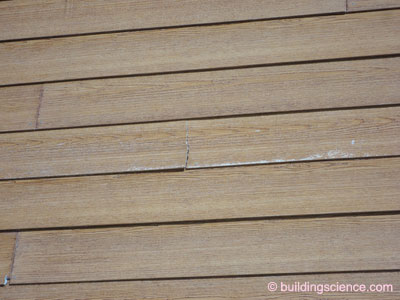
Photograph 7: Brittle Fiber Cement Siding—Fly ash added to fiber cement makes the stuff brittle and it tends to crack. The Tinkertoy sticks end up looking like spaghetti – but a stiff brittle spaghetti. This is not a good thing if you nail it and it sees winter.
Are we done yet? Nope. Remember the movie the Graduate? “I just want to say one word to you. Just one word. Are you listening? Plastics.” Not going to talk about vinyl siding here. Going to talk about the newer stuff. Expanded rigid polyvinyl chloride. Expanded PVC. Neat stuff, but very tricky to use. We see it used for trim and on decks and we are beginning to see it used as board siding.
Think of a Tinkertoy made out of coil springs that is wrapped with rubber bands where the spaces in the Tinkertoy are filled with stuff. What could possibly go wrong? Well, the stuff in the spaces gets driven off under the heat of the sun and the coil springs get fatigued so that the balance between the coil springs and rubber bands is upset. The rubber bands win and the material shrinks (Photograph 8 and Photograph 9). Is this the end of the world? Nope. But you had better be prepared for it and compensate for it because as of right now nobody makes stuff that this does not happen to.
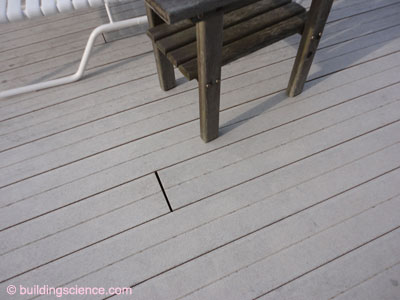
Photograph 8: Plastic Decking—Use shorter pieces to make the gaps smaller. But no matter what you are going to get gaps
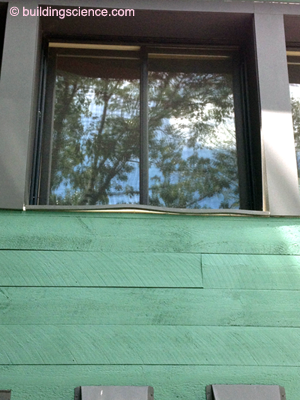
Photograph 9: Expanded PVC Trim—Painting it black is not a good idea. Guess what color it is at my place? Gets real hot when it is black. You can keep it straight even if it gets hot but you can’t stop it from shrinking. You have to live with the shrinkage. Use a sealant to hide it. This looks bad in this image but I stiffened it at the edge with a return lip and straightened it out.
OK, now we are done. I know this is not exactly the way things work. But it is close enough for engineers. And I know Charlie is grinning.
Footnotes:
- This column was inspired by Charlie Carll who passed away recently. He was at the Forest Products Laboratory in Madison, WI for as long as I remember. He had an encyclopedic knowledge of wood. He always had time for me when I asked dumb questions. The answer to every question I asked him usually started with: “Now Joe, I am pretty sure that is not how things work…let me help you out.” He was a kind and patient man who will be missed. Charlie liked the rubber bands, coil springs and spaghetti analogy in teaching youngsters even though it was not exactly how things worked. He said it was close enough for engineers and then he would grin.
Never does not mean never ever but means never unless really weird stuff happens—stuff that does not happen in buildings unless really, really weird stuff happens in buildings that should not be happening in buildings like fire. However, over time energy from the sun in the form of ultra violet radiation and heat “dry out” the sauce and the spaghetti does not slide past itself so easily. The spaghetti polymers begin to stick to each other. This is called “cross linking” Also, some of the ingredients in Mama’s sauce evaporate or are washed away or react with stuff in the air. The sauce gets sun burned and begins to disappear. So over time, particularly on the south and west exposures—the ones with the most sun—paint films tend to get more brittle.
- Sound familiar? Check out “BSI-047: Thick as a Brick” and that Fagerlund fellow
- Heat treatment to destroy fiber sorbtion sites, adding hygrophobic coatings to further treat fibers and boards and adding resins plus other secret stuff that I think I know about but am not sure but can guess at.
- Ludwig Hatschek. He was from Tesetice, which is now part of the Czech Republic. The Austrians claim him as when he was born there was no Czech country. He got the Swiss to make the stuff. So the Swiss claim the concept. It was perfected by the Australians so they also claim the concept. Good ideas tend to be claimed by everyone. With his name and heritage you can see why I like the guy.
- The Tinkertoy Construction Set was invented by Charles Pajeau. Pajeau was a stonemason which is entirely appropriate as we need his invention to understand concrete and fiber cement which were intended as replacements for stone.
- With the story of concrete we have got to mention John Smeaton, the engineer and Joseph Aspdin, the inventor here. Fabulous stories, but for another time. Look them up on Wiki. Better stories than what you find on cable.
